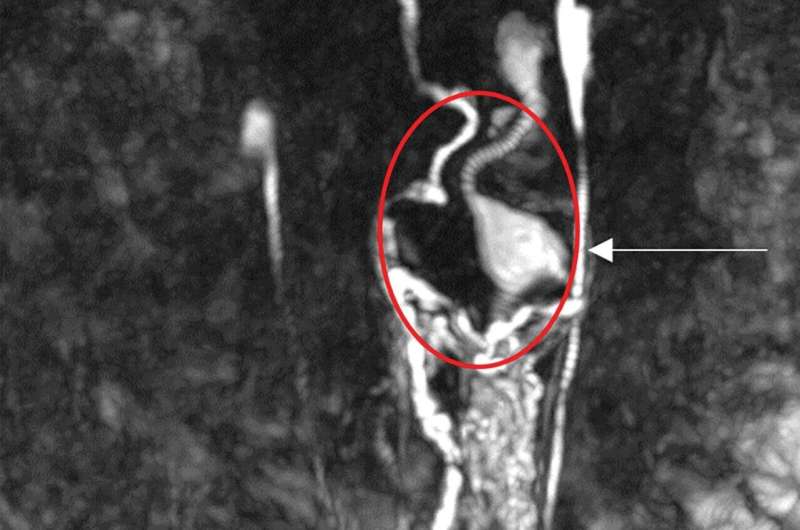This article has been reviewed according to Science X's editorial process and policies. Editors have highlighted the following attributes while ensuring the content's credibility:
fact-checked
proofread
World's first reconstructive surgery on the central lymphatic system using a microsurgery robot

Because it was not possible to remove a hard-to-reach bulge in the central lymphatic system, a team of doctors from the Department of Plastic Surgery and Hand Surgery at the University Hospital Zurich (USZ) created a new drain to relieve the patient's agonizing lymph congestion. For the first time, a microsurgical operating system was used for such a procedure.
By the time the patient came to the Department of Plastic Surgery and Hand Surgery of the USZ, she already had a long history of suffering and treatment behind her. The 47-year-old woman had been suffering from excruciating pain in her left abdomen for a long time, which intensified after physical activity.
Her pain was accompanied by severe circulatory problems, making it difficult for her to walk 100 meters at a time. As the symptoms increased, a dynamic MR lymphangiography was performed, which allowed the lymph channels and lymph nodes to be visualized.
The lymphangiography showed a cystic dilatation of the left pelvic lymphatic vessels about the size of a pear, in which lymph fluid was repeatedly accumulating. This led to massive pain and probably caused circulatory problems by influencing the autonomic nervous system as well as the spine.
Great suffering, but few treatment options
Such diseases of the central lymphatic system are rare but serious for those affected because they severely impair their quality of life. Congenital malformations of the lymphatic system also typically occur in infants and children, leading to massive problems such as chronic effusions around the lungs and in the abdomen with protein loss and extensive lymphoedema.
However, treatment is often limited to drug therapy and a special diet to reduce lymph flow; if there are leaks, attempts are made to sclerotize them. These lymph vessel malformations are rarely treated surgically because the surgical site deep inside the body is difficult to reach, and the lymph vessels are sometimes only 0.5-1 mm in size. The attempt in another hospital to sclerotize the enlargement had failed in the patient's case.
The robot could reach the bulge
After detailed investigations by specialists in several fields, a further attempt at sclerotherapy was rejected because of the risk of blocking the lymphatic vessels leading to enlargement. "This would have meant that the patient could have developed lymph congestion in the lower half of her body," says Nicole Lindenblatt, Deputy Director of the Department for Plastic Surgery and Hand Surgery and specialist in microsurgery and super microsurgery.
Instead, Lindenblatt's team suggested a reconstructive microsurgical procedure to the patient, in which a new connection is made between the enlargement and the left ovarian vein, allowing the lymphatic fluid to drain back into the central venous system.
The patient decided to have the operation. The procedure was planned together with an established treatment team consisting of specialists from visceral surgery and interventional radiology at the USZ.
The work is described in the journal Plastic and Reconstructive Surgery—Global Open.
The agonizing pain disappeared shortly after the operation
The operation was performed using the Symani robotic surgical system. This is the first time in the world that the microsurgical system has been used in an operation on a person's central lymphatic system, and the microsurgical procedure was successful. The patient's pain disappeared almost immediately after the operation.
Three months after the operation, she hardly felt any symptoms and had recovered so well that she was able to walk for several hours without any weakness or circulatory reactions and was no longer restricted in her everyday life.
Nicole Lindenblatt has been using the system since 2021 and was one of its first users. "We can use it to reach deeper layers and operate on the finest vessels with high precision and perform procedures that are very difficult with conventional instruments. Thanks to our experience with the system, we knew that we could also use it to perform such an operation on the central lymphatic system."
At the same time, this was the only treatment option for the patient. "We were able to help the patient with the procedure," says Lindenblatt, "and at the same time, we were able to demonstrate new applications and possibilities for the device that had not been used before."
More information: Lisanne Grünherz et al, First-in-human Use of a Microsurgical Robotic System for Central Lymphatic Reconstruction, Plastic and Reconstructive Surgery—Global Open (2023). DOI: 10.1097/GOX.0000000000005484




















